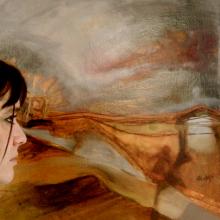
The twenty-six scenes depicted in Alison Auldjo's solo exhibition at the Union Gallery are loosely based on those she found herself among last summer, whilst painting in solitude around the Solway Firth.
There are enormous swathes of sky, and equally arresting acres of land: rolling moors, perhaps, or areas where Forestry has shorn the ground of cover. Trees stand in dense tangles or isolated in little groups of two or three, clinging to the earth, braced against storms past, present and future.
These are, of course, not strictly representational scenes but semi-abstract ones, explorations across mindscapes in search of refuge and succour. For Auldjo, the natural world can symbolise whatever difficulties confront her, yet by working them through – recognising them, analysing and arranging, incarnating them in paint – she also finds agency. Painting and nature are both the theatres of her anxieties and places of safety; working often in clay tones and browns and ochres, she can literally go to earth.
The result is paintings of extraordinary candour – beautiful at times, bleak at others, sparingly softened by hope and a touching confidence in mutual support, the protective charms of love.
In 'Safety in Numbers' (below), we see two doves circling in the air like lovers. To the left, the trees which might be expected to offer safety instead appear dangerously sharp and meshed; to the right, an expanse of open field offers no protection from the hawk or huntsman's gun. The sky is menacingly dark. The numbers do not seem adequate in the face of such threatening portents.
The work is full of fears and ironies: 'safety in numbers' was an artist friend's description of one benefit of marriage, shortly before Auldjo's wedding to Union co-manager Rob Dawkins. (A tiny heart and lucky horseshoe adhere to the foot of the canvas.) It is a work which I find interestingly difficult, partly for the way its composition does not conform to expectations, partly for the way it declines simplistic answers to hard questions. Its major themes are present elsewhere in the exhibition too: the vulnerability of human relationships; the fragility of art and artists in a hostile climate.
[img_assist|nid=2341|title=|desc=|link=node|align=middle|width=640|height=479]
Auldjo has written before of the influence on her work of the novelist Mary Webb (the exhibition's title is taken from one of Webb's books), but it seems to me suggestive also of older Scottish responses to survival in a challenging country. I am reminded particularly of James Hogg's folktales, where animals (as in 'Silent Observers of the Passing Seasons', below) can be inspiringly at one with their environment, and – as in 'The Longest Day with an Angel, Devil and a Hare' (top-right) – an uncanny medium between the human and the supernatural.
[img_assist|nid=2340|title=|desc=|link=node|align=middle|width=640|height=640]
Such charged realities could never make for bland, neutral or static artworks. They must be vectors, contracts in a constant process of reformation and renegotiation. This sense of unsettled business may explain the drama in Auldjo's works, her engagement with the unfolding of land, sky and sea, as in 'Beacon' (below), or the visceral, muddy, bloodied, scratched, smeared and gouged 'Battlescars' (foot of page).
[img_assist|nid=2342|title=|desc=|link=node|align=middle|width=640|height=526]
Auldjo says of working by the Solway Firth and coming to understand her own processes that although it 'may sound like an idyllic setting, it actually was hell ... a very stressful and emotional experience that I would not choose to go through again (although I know I will); but ultimately, out of that experience came some of the strongest paintings in the exhibition and, I believe, some of the best work I have ever produced'.
Presenting her own work in her own gallery was a risk for this artist, but one which most of those present at Friday's opening night agreed had amply paid off. It's really strong stuff – heartfelt, hard won and exhilarating. I urge you to see it. AM
Gone to Earth will show at the Union Gallery, 45 Broughton Street, until 5 December.
[img_assist|nid=2343|title=|desc=|link=node|align=middle|width=640|height=483]